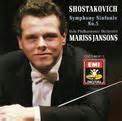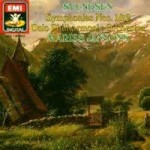The EMI Recordings 1987| Part Two
Shostakovich and Svendsen
In the previous post, The EMI recordings 1987|Part One, I wrote about how the OPO and Mariss made the transition from recording for Chandos to recording for EMI and wrote in some detail about our first EMI recording, an album of Tchaikovsky favorites, 1812 Overture, Romeo and Juliet and Francesca da Rimini. That was the first in a series of what would turn out to be fourteen recordings in the space of eight years. It was also the first of three recordings for EMI which were scheduled for 1987, to be recorded over a period of three months. And all this occurred during a period in which the orchestra was engaged in recording the Grieg Peer Gynt music under Esa Pekka Salonen for CBS, and finishing our commitment to Chandos with Tchaikovsky’s “Capriccio Italien.
The Shostakovitch 5th Symphony was one of Mariss’s specialties, and was scheduled to be played on the upcoming orchestra tour to the USA later that fall, so it was a natural candidate for recording.
In addition to the Tchaikovsky album, recorded back in March, and the Shostakovich, which was scheduled for late May, EMI asked Mariss to record an album of Norwegian music. Mariss chose to record the two symphonies of the Norwegian composer Johan Svendsen. These were scheduled to be recorded in late August, at the beginning of the concert season. Together with all the other recordings, plus the projected BBC Proms tour in early August, and the USA tour in November would make for the busiest of seasons for the orchestra, and the busiest since I came aboard in 1983.
Shostakovich: The Sessions
As with all of our recording sessions, those for the Shostakovitch took place in the Oslo Konserthus. David Murray was the producer, with Mike Clements again acting as sound engineer, with the assistance of Charles Almas of the NRK. If memory serves me correctly, we had two days to “play” the symphony in, and three days to get it on tape, edits and all. Mariss got the orchestra ready in his usual thorough
manner, and by the Wednesday, we were ready to go. My colleagues in the percussion section were ready to go as usual, as was I. For this recording, I had the three Light drums (31 inch chain, 29 and 26 inch Metro Bs) and a 25 inch Hinger on top. (Not that I used it that much, it was there more for insurance in case a head gave way, which with plastic was highly unlikely, but one never knows.) For mallets, I was still using Feldmans and Hingers. Hor the first movement, I used wood shafted Hinger generals; for the second movement I used Feldman blue hards; Feldman greens for the nthird movement, and Feldman reds for the opening and coda, with the Hinger greens and reds for the rest.
The symphony, while not the hardest in the Shostakovich canon, is nonetheless tricky and not easy to get right. More conservative in tone than the fourth symphony, it nonetheless requires finesse and polish to bring it off. For the timpanist, there is not that is technically over-challenging except for the quick repeated double-stops in the last movement. The challenges are mostly musical ones. The end of the first movement comes to mind – to accurately gauge the delicacy of the As and Ds – and to make the rolls as smooth and soft as possible. Sensitivity is the key here. The second movement needs to be spot on and the little solo towards the end – the e s and low Fs with the decrescendo have to be graded just right. There isn’t much to lay in the third movement, but what there is has to be played with sensitivity and one needs to arrive on the C after the low G roll with exactness and confidence.
The finale is another matter. One begins it with a roll on d, and then there’s the repeated eighth notes on d and A, and the quick “gear”change at the end of the passage – at least that is what Mariss asked for and got. I used Feldman reds here, and they worked well enough. Then there’s the double-stop passage which acts as a sort of brake before the run-up to the coda. I just prayed that Mariss wouldn’t take it too fast – playing repeated double-stops at speed is not a lot of fun. Luckily, he took it at a brisk tempo, but not too brisk. I was able to manage it without a lot of strain.
For the coda, Mariss opted for the slower tempo, rather than the quick tempo of the Bernstein 1959 recording. I think it makes more sense, as the slower tempo conveys more accurately the underlying message of the composer “Yes, I rejoice, but only because I am forced to.”
Shostakovich: Afterthoughts
The sessions went well, and the recording was released several months later. After listening to it then, and now, I still find that it has a lot of power and was well played. Unfortunately it was only in the active catalog for about six or seven years before being supplanted by a recording that Mariss made with the Vienna Philharmonic in the early to mid nineties. Good as that one is, I felt the OPO version has more raw energy. EMI has still not seen fit to re-release it, which is a pity.
Also, if I had to do it over again, I most probably would have used the Hingers, as they had more weight for the tutti passages. However, I was and still am satisfied with the overall result.
Svendsen: The Sessions
Jut after returning from our early August visit to London for our appearances (the first of many) at the BBC Proms and London, we began preparing for the next round of recording. This would be the third recording project for EMI after the Tchaikovsky and Shostakovich albums and was to be devoted to music of a Norwegian composer from the 19th Century. Mariss chose and EMI agreed to the selection of the two symphonies of Johan Svendsen, who was a contemporary of the more well-known Edvard Grieg. While Grieg was known for his harmonization and use of melody, Svendsen was known for his skill at orchestration and handling of larger scale works for orchestra.
The two symphonies have a lot of charm and are well constructed. My favorite is the first, because of its rhythmic drive in the first movement, the nobility of the second movement, and the charming scherzo. The second symphony is also a good work, especially in the first movement, with it’s opening statement, but for me bogs down a little but after that opening.
The orchestra was in fine form after our BBC visit, and if memory serves me correctly, we were able to play the Svendsen symphonies “in” in concert, prior to the recording sessions. I am not clear whether or not we played them in a single concert program or with each as the main work on a separate program, but I do know that we did them in concert before recording.
For instruments, I used just the three Light timpani that we had: the two Metro Bs and the 31 inch Continental chain. Heads were the hazy Remo insert ring heads with the false backbone down the middle. For mallets, t was the usual Hinger and Feldman combinations, with the addition of a pair of shorter-shafted aluminum Hinger mallets (with small felt heads – more of a “red” type of semi hard stick) given to me by Dan Hinger during my visit back to the States in the summer of 1986. I used these in the first symphony, and I liked their weight, attack and projection.
The concerts went well, and then it was time for the sessions. David Murray was again producer for the sessions, and Mike Clements was back as balance engineer, assisted by Charles Almås. Since there was no percussion involved, I was again on my own, and as a matter of fact, the orchestra required for both works was of a fairly modest size. While I enjoyed recording with the orchestra, I always enjoyed the company of my colleagues on a project and missed them when they weren’t required.
The sessions went very well. Mariss was able to get his ideas across quickly, and the music was in the orchestra’s blood so to speak, so other than Mariss’s interpretive details, there was mustn’t much else to do but put the thing on tape. Which we did with dispatch.
In listening to the recording, both at the time of release and now, I am struck by how fresh the first symphony sounds and what a good piece it is. The second symphony has its moments, particularly in the first movement, and is played well, but for me it was a problematic work to record. First off, the timpani part for the first movement is scored for the low F and B flat, which don’t come off acoustically as well as do the A and d of the first symphony. I used my hardest mallets, but I was handicapped as it was what I called a “mushy part” – hard to articulate, as there were a lot of rolls of short duration, and if I played “out”, I’d get the hand – which meant “hold back.” Maybe that influenced me against the symphony at the time, but in listening to it today, twenty-eight and a half years after recording it, I realize that Mariss was right. He needed to get the detail out, and the timp part was very much a background detail. I also have come to a better appreciation of the symphony. It kind of grows on one.
Here is a link to our recording of the Symphony No. 1, First movement. Enjoy!
Above is the finale from Shostakovich 5! Enjoy!



Recent Comments